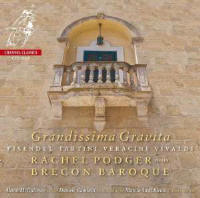Texte paru dans: / Appeared in:
Channel Classics |
|
|
Reviewer:
Robert Maxham
Rachel Podger, Alison
McGillivray, Daniele Caminiti, and Marcin Świątkiewicz have assembled a
program of violin sonatas by four 18th-century violinist composers: Antonio
Vivaldi, Giuseppe Tartini, Francesco Maria Veracini, and Johann Georg
Pisendel. They open it with Vivaldi’s popular Sonata in A Major, op. 2/2 (Ottorino
Respighi made a modern arrangement), bringing plenty of fancy to the opening
movement. The imagined conversation between the four in the notes focuses
largely on Bach and Corelli; and the ensemble’s playing of Vivaldi’s sonata
makes its debt to Corelli preternaturally clear. But the sprightly Podger
also exhibits its almost improvisatory manner no less frequently and no less
clearly than do the continuo players. Tartini’s three-movement sonata from
his op. 2 steps further away from Corelli’s models harmonically and
melodically, although Tartini revered the older master to the point of
writing a set of variations on a Gavotte from Corelli’s op. 5 that explored
encyclopedically the contemporary art of bowing. Podger and the ensemble
sound wistful in the opening movement (in this performance, more than twice
as long as the final two combined), but they acquit themselves in the two
later movements’ intricate passagework with energetic verve. The first of
Veracini’s four movements seems cast in a dark G Minor indeed in Podger’s
performance; it’s an Affekt to which the succeeding Capriccio provides a
cheerful and fanciful counter. The Allegro assai, with the roulades Podger
interpolates also makes a sweeping impression; and the ensemble brings the
sonata to an energetic conclusion in the final Giga.
Pisendel’s Sonata in C Minor
sounds even more extravagant in its expressive aspirations, opening with an
Adagio that might have been conceived light years after Veracini’s sonata,
although it suggests an academic working out of Corelli’s form (with a
quasi-fugal second movement) more than it does any foray into an advanced
galant style. Here, the contrapuntal complexities themselves command
attention quite aside from the felicities of the ensemble’s performance. The
weighty reading of the third movement gives way to a sprightlier one of the
final Giga. Veracini’s Sonata, op. 2/12, contains both a Passagallo and a
final Ciaconna. The passacaglia’s chromaticism provides opportunities for
many affecting gestures, and the ensemble takes striking advantage of them.
The Capriccio chromatico that separates the two ground basses also exhibits
strong chromatic inflection, but the final movement (perhaps a tribute to
Corelli’s La Folia), about as long as the first two movements combined,
offers the ensemble a study in contrasts, vivacity alternating with more
serious contemplation.
The program comes full circle
with an Adagio from a sonata Vivaldi wrote for Pisendel. For the music and
its exuberantly creative performances, the Brecon Baroque’s collection
deserves a strong recommendation. | |
|
|
|
|
|
|
|
Cliquez l'un ou l'autre
bouton pour découvrir bien d'autres critiques de CD |
|




